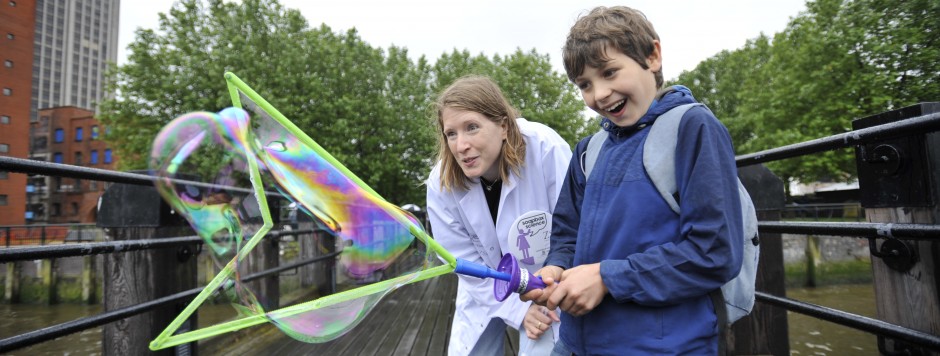 Dr. Roopali Chaudhary (@chaudr8), Founder and CEO of Lotus STEMM, will be taking part in Soapbox Science Waterloo on June 9th with the talk “Trust your gut reaction!! How your intestinal immune system protects you from the inside”
Dr. Roopali Chaudhary (@chaudr8), Founder and CEO of Lotus STEMM, will be taking part in Soapbox Science Waterloo on June 9th with the talk “Trust your gut reaction!! How your intestinal immune system protects you from the inside”
SS: What is your earliest memory of being excited by science?
From my earliest memories, I remember being fascinated by how the world works; our bodies, plants, the TV, everything was fascinating. My parents tell me that when I was 2-3 years old, I insisted (threw a tantrum) that they buy me a doctor play set. I remember my little stethoscope from which I listened to all my stuffed toys heartbeats. I always insisted I’d be a doctor, and during my undergraduate degree, I actually realized that it wasn’t a medical doctor; it was a scientist’s career that intrigued and excited me. Solving puzzles was a common pastime in my house, and I grew up loving the feeling of putting two unlikely pieces together to get a bigger picture. This is not very different from the scientific method.
SS: What is the most fascinating or surprising aspect of your research/work?
Intestines, to me, are one of the most fascinating organs. I mean, they help make poop! And we are all fascinated by poop at some point in our lives. Poop can tell us a lot about our inner health. And intestines, though they are inside you, they are still connected to the outside world. Everything you eat or drink will go through them, and while they help absorb the nutrients you need, they also help protect you from various harmful microorganisms. Intestines have evolved and developed such that there is a clear distinction between nutrients and harmful microorganisms. It’s amazing that this homeostasis is intricately maintained. Slight changes can lead to long-term detrimental effects. BUT not only do intestines differentiate between nutrients and harmful microorganisms, they also differentiate between beneficial and harmful microorganisms. Intestines develop in the presence of millions of bacteria, and this symbiotic relationship helps the intestinal immune system develop, which further helps intestines fight against the harmful microorganisms. It’s a complex interplay between our bodies and the microscopic world. And poop!
SS: What is the funniest or most memorable thing that has happened to you while working in science?
So many memories! It is difficult to pinpoint just one. Science helped me find some of my closest friends, who have all shared in this beautiful journey. But if I had to give one experience…my very first position was a research assistant during the summer after my 3rd year of university. This was the first time I was in a “real” lab. We worked on live imaging of developing fruit fly embryos. Within my first week, I had to learn how to prepare these tiny embryos for imaging. I remember my supervisor mounted the embryo on a slide and told me “Don’t drop it”. While he went to the other room to grab his notebook, I fumbled and dropped the slide, embryo face down. I quickly picked it up, and pretended nothing happened and hoped that it was not going to be noticeable. He, of course, looking through the microscope saw a squished embryo. That was the first and only time I dropped a slide with a live sample on it! Lesson learned!
SS: What attracted you to Soapbox Science in the first place – and what are you most looking forward to in taking part?
Soapbox Science is a challenge! As scientists, we learn to communicate our data/findings to other scientists early on. We get so caught up in the jargon; we forget that communication to the general public is just as necessary to promote citizen science and curiosity in the next generation. I’m excited to communicate my research in non-conventional ways. On top of that, it is a platform to showcase women scientists! I’m so excited to stand beside strong powerful women who are pushing their comfort zones as we all talk about the different topics you can study as a scientist.
SS: If you could change one thing about the scientific culture right now, what would it be?
The concept of “Publish or Perish”; I would definitely get rid of this! We lose so many good scientists because circumstances prevented them from publishing enough papers, OR publishing in high impact journals. Publishing papers is expensive, and if a lab does not have many grants, they may not be able to publish papers during a student’s cycle in that lab. Furthermore, a student/researcher may have other life circumstances (health, family, personal finances, etc) that may also affect their ability to publish. Not to mention sometimes science experiments just don’t pan out.
SS: What’s your science superhero power?
Contagious excitement about science! I love talking about science and instilling childlike curiosity about the world around you!
SS: Do you have a few words to inspire other female scientists?
Imposter syndrome is real. If you think you can’t do something, or don’t deserve to be where you are, or others are smarter/better/more hardworking than you; it’s imposter syndrome because you deserve and worked hard to be here. You are good at what you do, which may not be the same things as your lab/workmates, but that is part of the diversity of science. Believe in yourself, and find your champions!
SS: What is a typical day like for you?
It differs from day to day. I can spend a whole day in front of the computer (writing/reading papers, grants, e-mails, or analyzing data), but then again, I can also spend a whole day chatting with students about their research. Since my research is on mice intestines, I will go to animal facility and look at my mice to make sure they are healthy; I do this often as a stress relief. I also have days of long experiments, which start as early as 6:30 am and end by 2-3 am. On these days, I collect tissues along with my colleagues, process them to the single cell level, add markers for my proteins of interest on these cells, and then run them through a machine that provides me information about how strongly the markers are present on the different cell types.
